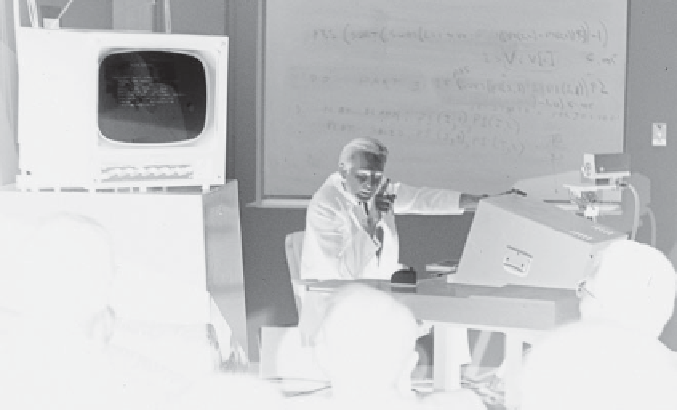Information Technology Reference
In-Depth Information
FIGURE 1.16
Douglas Engelbart rehearses for his presentation at the 1968 Fall Joint
Computer Conference that is still called “the mother of all demos.”
(Courtesy of SRI)
[45]. Others thought Engelbart's ideas were completely impractical, noting that he was
treating a computer as if it were for his personal use.
Alan Kay saw Engelbart's demo, understood the ramifications of the NLS, and was
eager to take the next step. In 1970 he became one of the founding members of Xerox
Palo Alto Research Center (PARC), a new facility dedicated to performing research into
digital technology. The research team created the Alto, a small minicomputer designed to
be used by a single person. The Alto incorporated a bitmapped display, a keyboard, and
a mouse. Kay played a leading role in developing the Alto's graphical user interface that
responded to the point, click, and drag operations of a mouse. In order to link together
the Altos, the Xerox PARC team also created
Ethernet
, which became a networking
standard throughout the computer industry. Ultimately, however, Xerox failed in its
attempt to market a commercial personal computer.
In 1979 Apple Computer sold 10 percent of its stock to Xerox. In return, Xerox let
Steve Jobs and some Apple engineers visit Xerox PARC to learn more about its research.
Jobs returned from the visit committed to building a computer with a graphical user
interface. A few years later Apple released the Lisa, a $10,000 personal computer with
a graphical user interface. The price tag was too high, the processor was too slow, and
the Lisa was not commercially successful. However, in January 1984 Apple released the
Macintosh, a faster $2,495 computer with a graphical user interface. The Macintosh was
an instant hit: Apple sold 300,000 in the first year.
During the 1980s IBM, VisiCorp, and Microsoft all offered graphical user interfaces
for IBM PC-compatible computers, but they could not compare in sophistication to the
interface of the Apple Macintosh. Finally, in May 1990 Microsoft released Windows 3.0

